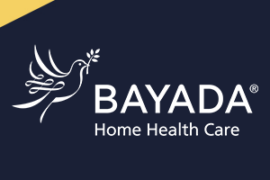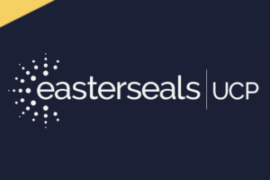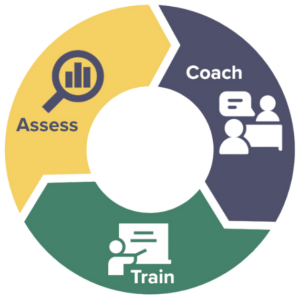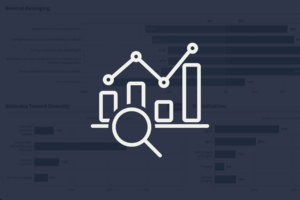The Great Resignation has arrived.
Today, perhaps more than ever before, employees are thoughtfully reassessing their relationship with their work, their colleagues, and their organization. In the wake of 2020’s global pandemic and greater spotlight on racial injustice, 2021 has been a time of reckoning for many people who are asking themselves: Does my current work environment serve me? Is my work fulfilling? Why, or why not? Do I have a clear path to grow in my role or in my company’s organizational structure? And, does this job allow me to reserve enough time and energy for the things that really fuel me, so I can bring my best self to work each day?
Unequivocally, employees have leverage in today’s job market. They’re deciding which benefits mean the most to them, and they’re not settling for lackluster commitments when they approach the negotiating table. This means a new call for flexibility, introspection, and thoughtfulness on the part of not only recruiters and hiring managers but also business leadership. It also means calling organizations into greater accountability as it pertains to diversity, equity and inclusion (DEI) best practices—a commitment that creates strong corporate culture and improves bottom-line results.
In short, the data is clear. Job seekers care about DEI. In fact, according to a 2020 workplace survey by Glassdoor, more than 76% of employees and job seekers say a diverse workforce is an important factor when they’re evaluating companies and job offers. And that percentage is even higher when we listen to underrepresented folks: about 4 in 5 Black, Hispanic, and LGBTQIA+ job seekers and employees feel similar.
The working world is becoming more digitally and culturally connected. That means your next superstar hire could be well outside of previously-established geographic boundaries. If companies hope to attract and retain diverse, high quality talent on a global scale, it will require leadership investment in DEI recruitment goals, as well as explicit, transparent integration of DEI principles to company mission, vision and values.
What sentiment do you hope a prospective employee will have when they’re engaging with your organization throughout the hiring and onboarding process? What key differentiators do you offer that will set your organization ahead of the pack? When job seekers are contemplating a resignation or a job offer, there are a number of facets that influence their individual decision making. Some will fall beyond your influence. Others you can impact by setting the table to make your organization more attractive to high quality candidates from diverse backgrounds and groups. Let’s explore a few of the commitments that will help make your organization more attractive to topflight talent.
Read the room on benefits.
If you want to be an employee-focused organization that consistently wins top talent in the market, it’s critical that you look beyond foundational, baseline compensation packages. Since the U.S. doesn’t mandate social support for employees, it’s up to companies to make those benefits decisions individually. Create customized employee benefits packages that express your corporate values and culture, then use those benefits as an opportunity to attract the best possible talent. For instance, you might consider unlimited paid time off, flexible work schedules, gym benefits, childcare stipends, commuter benefits, paid volunteership, and/or repeated opportunities for personal skills development.
Additionally, view your hiring practices from the employee point of view during the application process so you can make the end-to-end experience worth their while.
- Be transparent about compensation ranges in your job postings. Don’t hide this information until an offer is made. At that point, many employees will have already spent a significant amount of time and effort researching your company. Knowing if your compensation package is a good fit for their lives, skill set, and family needs is an important prerequisite. Plus, it signals that your organization practices transparency and cares about pay equity.
- Be flexible about which benefits mean the most to employees once negotiations begin. No worker is returning to a workforce that remains unchanged by COVID-19. In fact, Harvard Business School recently found that 80% of people who are working remotely don’t want to return to the office full time. Another online survey showed that 30% of workers would quit their job if asked to return in-office full-time, and more than half (61%) of employees prefer a hybrid work model where they can spend a few days working from home and come into the office only when truly necessary to access resources or work with their teams. Every year, families and employees place even more emphasis on the importance of flexible work schedules and environments. Ignoring these huge cultural shifts may reflect an antiquated outlook on workplace evolution.
- Stay competitive when updating benefits packages based on current events. Two years spent in an ambiguous cultural environment and global pandemic has been an immense change for both your employees and their families. Now may be the time to re-assess whether you can invest in mental health services to help employees process the dynamic nature of this season. Even if offered only on a temporary basis, consider either on-site therapy resources or virtual therapy visits that employees can utilize as part of their benefits package.
- Bring the basics, then look beyond them. If you can’t provide paid family leave, consider partnering with startups who can. If you’re finding that in-office work means added expenses for transit and/or childcare, offset those costs with stipends, or lessen the burden with other incentives. If you can’t necessarily adopt a work-from-home model, you may want to enhance compensation packages for hourly, in-person essential workers by providing lucrative benefits like debt-free education. For example, Target is providing employees with free education in partnership with Guild, which seeks to close the education gap while folks are on the job.
Lastly, show respect for your prospective employees’ time. Let candidates know immediately if they aren’t the right person for the job. Follow up on applicant questions promptly, and use their time in interviews as effectively and efficiently as possible. Most candidates are juggling multiple applications and interview processes simultaneously, and so, they’re likely to compare your process to others they are working through. Inefficiencies and disrespectful behavior will hurt your competitive edge. In short, be kind, and be professional. A little human compassion can go a long way.
____
It’s not enough simply to lure employees to your team with promises of a compelling work environment. You must also have the right corporate practices in place throughout your full employee life cycle so you can ensure that employees are satisfied and committed to remain on your team. Ideally, your new hire will evolve into a tenured employee doing their best work, advocating on behalf of your organization both in and outside of their role, and enhancing the experience of the colleagues around them.
Keeping employees motivated and engaged is often easier said than done, though. How can you retain the high quality candidates you worked so hard to gain?
Onboarding isn’t the end.
For many employees, the first few weeks of work at any new company mean training, slideshows, introductory conversations, and hours spent taking notes. Three months into the job though, and the inertia just… stops. When that first to-do list has been accomplished, it’s time to check in and make sure both parties feel satisfied and confident that expectations have been met. Is the employee feeling happy with their role, and do they feel a sense of belonging and inclusion in the corporate culture that surrounds them? Is it clear what is expected of them, and how you will define success? And also, is the manager or supervisor happy with the work that this employee is doing? If not, make a plan to address any obstacles that are getting in the way of a positive work experience.
Map a clear trajectory for growth.
Ask your employees how they want to grow and where they see themselves personally and professionally in the next five years. Make sure to clearly communicate which metrics you will use to define success, how often evaluations will happen, and at what point you will consider advancement opportunities like raises and promotions? In many organizations, the answers to these questions are vague at best and can leave employees feeling uncertain of their role or too intimidated to ask for clarification.
When faced with uncertainty and ambiguity, many employees will simply assume forward progress isn’t possible, and they will move on quickly. Keep the lines of communication open from HR, between managers and employees, and throughout your entire organization so that employees know about internal openings and professional opportunities, as well as opportunities to speak with supervisors about wins, potential sponsorship or mentorship, and how to bolster their professional portfolios.
Don’t just leave room for joy; create a culture where employees can actively pursue it.
This may mean making small departures from traditional benefits packages by offering regular afternoons off or three-day weekends at predictable intervals. It may also mean more intentional conversations throughout the recruitment process plus external marketing to shed a light on all the things your business is doing to create an employee-focused workplace culture of personalization, flexibility, and care.
As The Diversity Movement’s CEO, Donald Thompson, explains, “If you want to win the talent wars and retain your current employees, you have to create an employee-focused culture by personalizing the employee experience […] Personalization is the new employee economy. If you’re not personalizing the ways you incentivize, inspire, accommodate and give feedback, you’ll lose out to someone who can. Employees are the engine of every business. The strongest organizations will always be the ones that nurture engagement, loyalty, and trust by creating a personalized and employee-centered culture.” Those who create custom solutions tailored to DEI goals—as is top of mind during Global Diversity Awareness Month—will further separate themselves from the pack.
At its root, work offers a way for people to build their own success, provide for their families, and create a better world. If we want new candidates to choose us and current employees to stick around, we have to be willing to adapt to their needs, especially in the wake of these last few turbulent years. In 2022 and beyond, the places people want to work will be places that align their stated values with daily practices for strong, employee-focused cultures. That means, re-examining your benefits package, pathways for professional advancement, and metrics for success.














